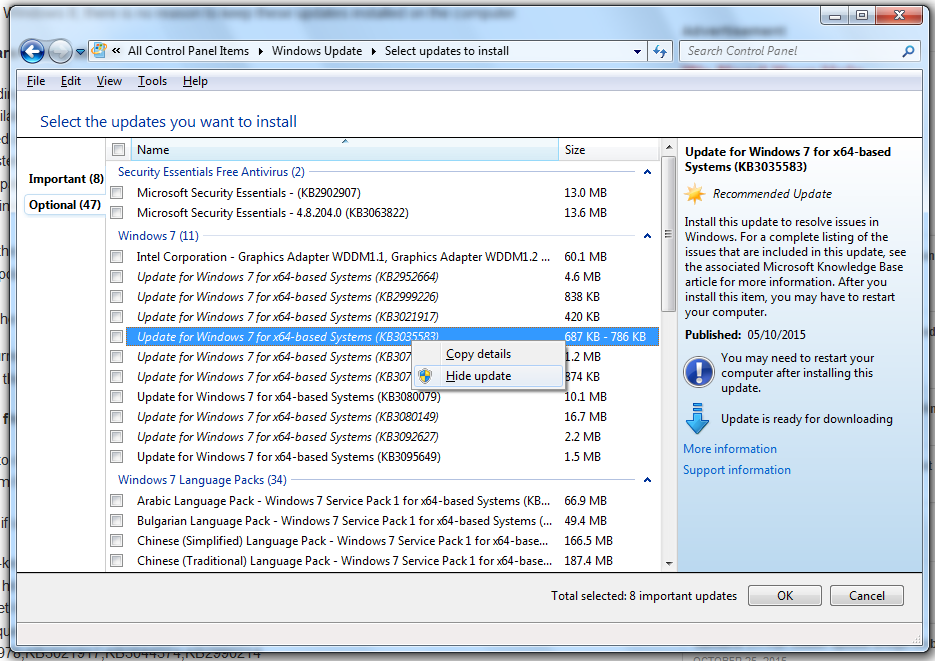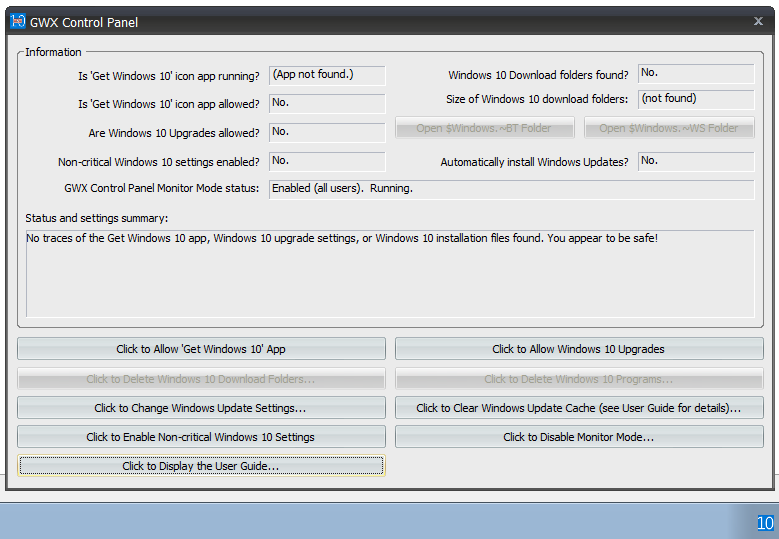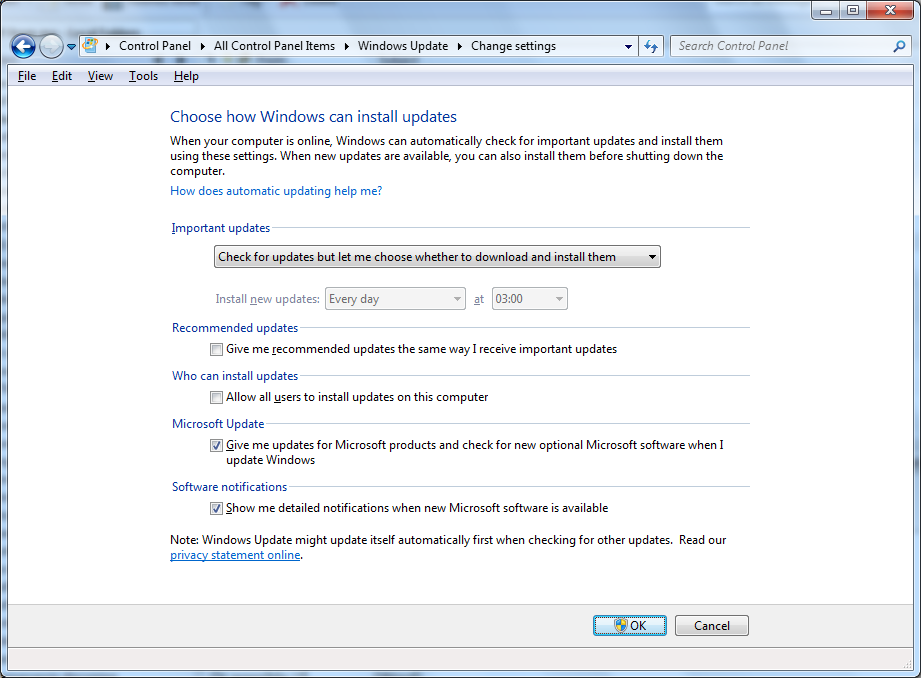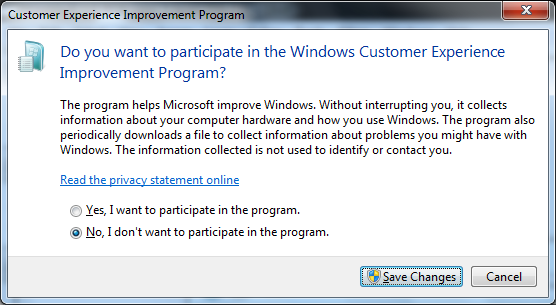DON'T enable automatic updates in Windows 7!!! Read here for why...
The basic problem
UPDATE: GWX Control Panel
Preventing the nagware updates from getting installed in the first place
This will obviously prevent any updates from being automatically installed. You will still want to install the good updates. Basically you have to go through the updates and make sure they're not in the "list of Windows 10 nagware/malware updates" below. Most of the ones in the list are marked as "Recommended", but are still down as "Optional" rather than "Important" (automatic updates will still auto-install "Recommended" updates). However, one or two are still marked as "Important" updates, so make sure you trawl through both "Optional" and "Important" updates, only installing good ones.
Note that whilst you're trawling through, selecting which updates to install, you can "hide" the bad updates like so:

However, I don't trust this "hide" mechanism long-term. Hidden updates have been known to come back and get installed anyway, so only ever use "hide" as a temporary mechanism to help you screen out the bad updates in this session. ALWAYS check to make sure you're not installing malicious/nagware updates each time you periodically do manual checks for new updates (which you will have to do, as automatic updates are now disabled).
Once updates have been installed, you'll want to immediately go into PowerShell and check that you didn't accidentally install any of the bad updates, uninstalling them immediately if you did:
get-hotfix -id KB3035583,KB2952664,KB2976978,KB3021917,KB3044374,KB2990214,KB3083711,KB3083710,KB3068708,KB3022345,KB3075249,KB3080149,KB3112343,KB3123862
By the way, turn off CEIP too!
Removing the updates after they've already been installed
With that said, the first thing to mention is what NOT to do. Don't bother using a registry hack to hide the icon. Although one exists (HKEY_LOCAL_MACHINE\SOFTWARE\Policies\Microsoft\Windows\Gwx\"DisableGwx"), it still leaves the frankly malicious Microsoft nagware software on your hard drive which might end up downloading GIGABYTES of Windows 10 installation files "just in case" you decide you want to switch to Windows 10. You'll be wanting to get these updates off your system, and keep them out. They're basically malware; you don't hide it, you remove it.
So you'll want to remove the updates (make sure you disable automatic updates FIRST so they don't come back automatically!) The following, at the time of writing, are the offending updates that may result in nagware being installed and/or GIGABYTES of Windows 10 installation files being downloaded to your hard drive (thanks to this ghacks article for this info).
List of Windows 10 nagware/malware updates:
- KB3035583 - According to Microsoft, this update enables "additional capabilities for Windows Update notifications when new updates are available".
- KB2952664 - Labeled a compatibility upgrade for upgrading Windows 7, its purpose is to "make improvements to the current operating system in order to ease the upgrade experience to the latest version of Windows".
- KB2976978 - A compatibility update for Windows 8.1 and Windows 8 which "performs diagnostics on the Windows system [...] to determine whether compatibility issues may be encountered when the latest Windows operating system is installed".
- KB3021917 - Does the same as KB 2976978 but on Windows 7.
- KB3044374 - This update for Windows 8.1 enables systems to upgrade from the current operating system to a later version of Windows.
- KB2990214 - Does the same as KB 3044374 but on Windows 7.
- KB3083711 - Listed as a "new update client" for Windows 8 - seems unnecessary. Highly suspicious.
- KB3083710 - Same as the "new update client" above, but for Windows 7. Highly suspicious.
- KB3022345 - Adds telemetry. Avoid.
- KB3068708 - The "upgraded" version of the above patch that adds telemetry. Avoid.
- KB3075249 - Supposedly "adds telemetry points to the User Account Control (UAC) feature". Avoid.
- KB3080149 - Adds CEIP telemetry. Avoid.
- KB3112343 - This update "enables support for additional upgrade scenarios from Windows 7 to Windows 10". Need I say anything more?
- KB3123862 - Gives "updated capabilities to upgrade Windows" to Windows 10.
Microsoft notes that users should not remove or block the updates 3044374 and 2990214 as they are used for Windows Update functionality and not only to upgrade to Windows 10. But screw that. You should block them.
They may already have been installed. Firstly, to tell which ones are already installed, open a command prompt and type powershell. Once you're in PowerShell, type:
get-hotfix -id KB3035583,KB2952664,KB2976978,KB3021917,KB3044374,KB2990214,KB3083711,KB3083710,KB3068708,KB3022345,KB3075249,KB3080149,KB3112343,KB3123862
This will give a list of which of the offending updates have already been installed or (if you're lucky and none of them have been installed) will give you an error message in red about how the command "cannot find hot-fix on the machine..." If you get the error in red, you're OK and none of them have been installed. Otherwise, you'll need to uninstall each one listed one-by-one. Do this by (still in PowerShell) using the following command for each hotfix:
wusa /uninstall /kb:2952664
... where 2952664 is the ID of the hotfix in question to uninstall. Note that this is a very unideal way to do things (much better not to install them in the first place) and I have personally found that sometimes the uninstall won't work completely and although the uninstaller will claim to have uninstalled the hotfix, it sticks around. For instance I can't get rid of "KB2952664". Just won't go away. So yeah, avoid installing these things in the first place.
Removing the GIGABYTES of Windows 10 installation files that may have been downloaded to your hard drive
First, make sure you have the handy "unixutils" bin directory in your path; you'll be needing its "rm" command. Then, write a killMS.bat file with the following contents, and run it inside a command window opened as Administrator. Once it's completed and hopefully deleted the waste-of-space directory, it can itself be deleted.
@ECHO OFF
CLS
ECHO Project "terminate $Windows.~BT folder" - Jeremy Morton
ECHO =======================================================
ECHO Assuming the $Windows.~BT folder is on drive C: - if not, please Ctrl-C now and
ECHO modify this batch file to the appropriate drive letter.
PAUSE
C:
cd "\$Windows.~BT"
ECHO.
ECHO Taking ownership of all the directory's files (YOU SHOULD GET A BUNCH OF
ECHO SUCCESS MESSAGES; THESE ARE OK, AND THE OPERATION HAS NOT FAILED).
PAUSE
takeown /F *.* /R /D Y
PAUSE
ECHO.
ECHO Granting full rights to everyone for all the directory's files.
PAUSE
icacls *.* /grant Everyone:(OI)(CI)F /T
PAUSE
ECHO.
ECHO Terminating the $Windows.~BT directory.
PAUSE
cd \
rm -rf "$Windows.~BT"
ECHO.
ECHO Finished. Press a key to exit.
PAUSE



